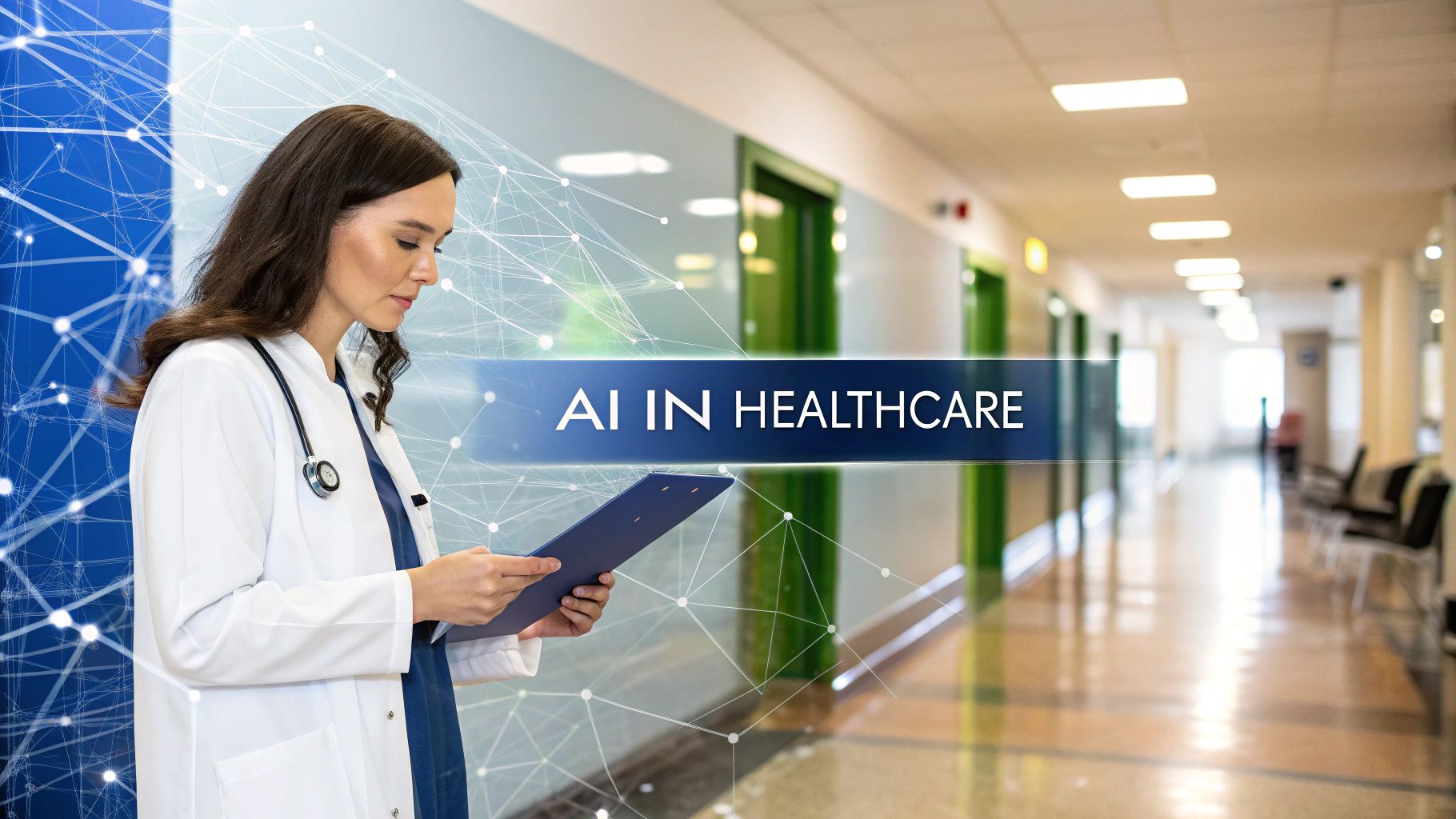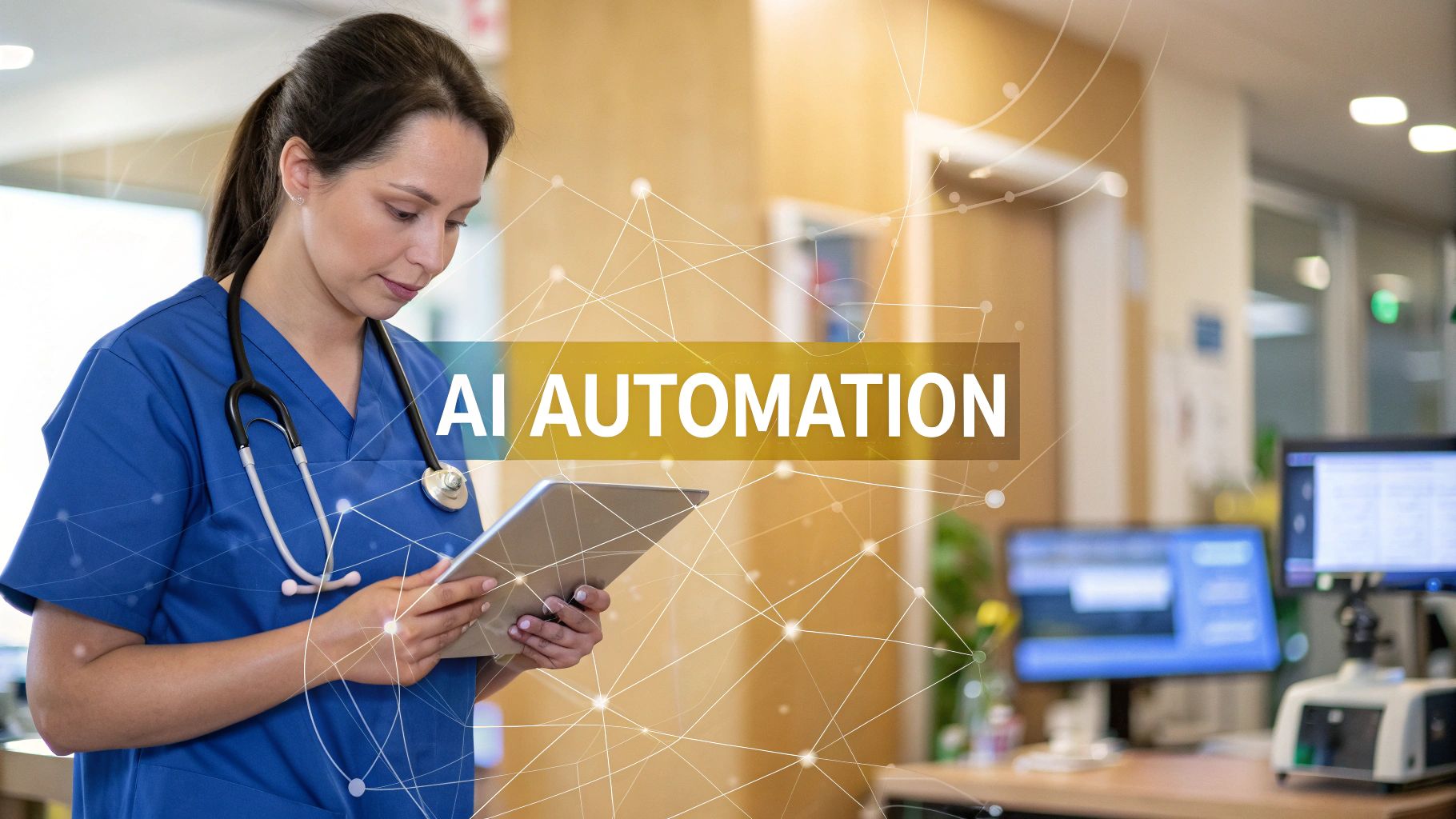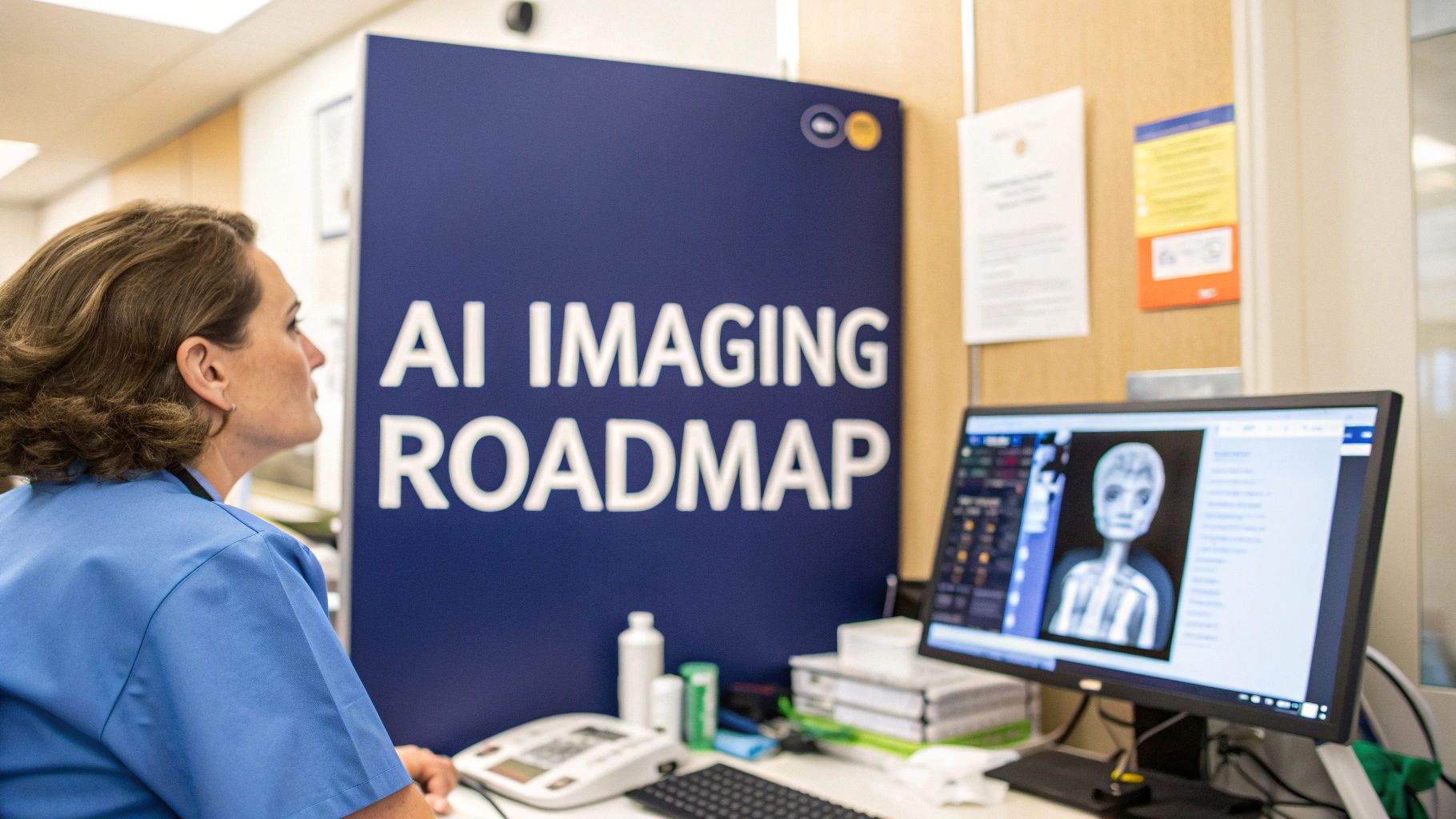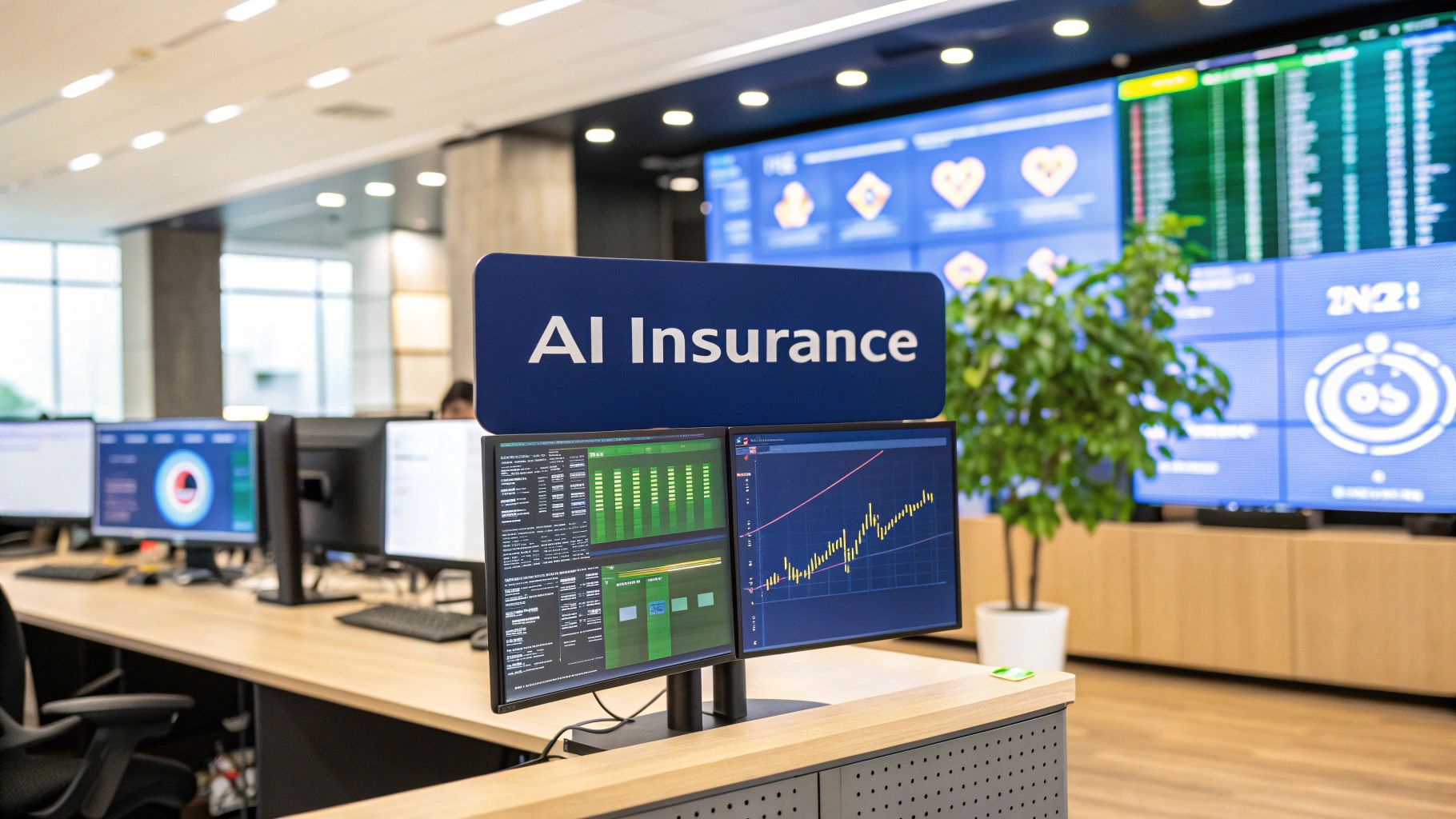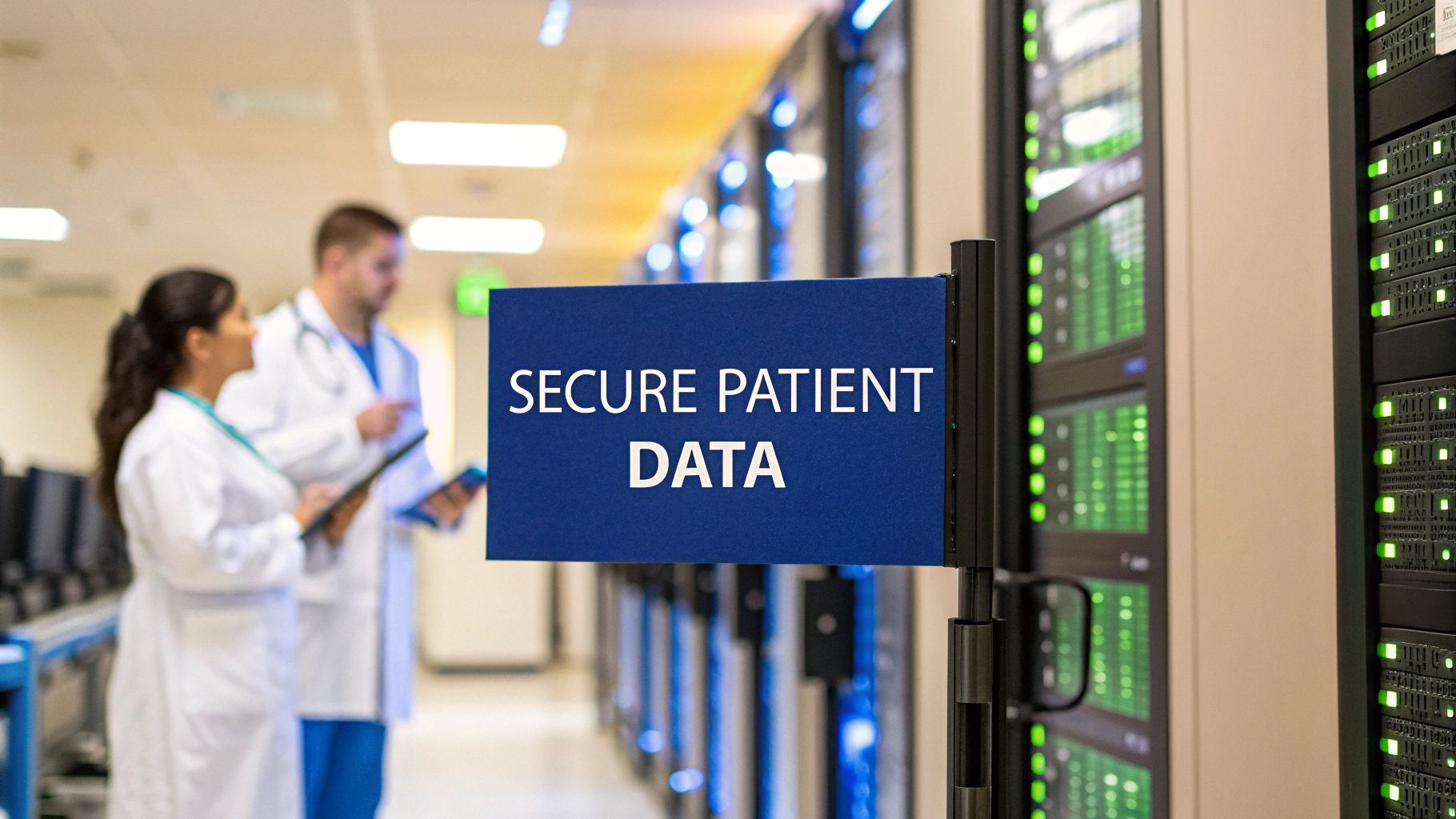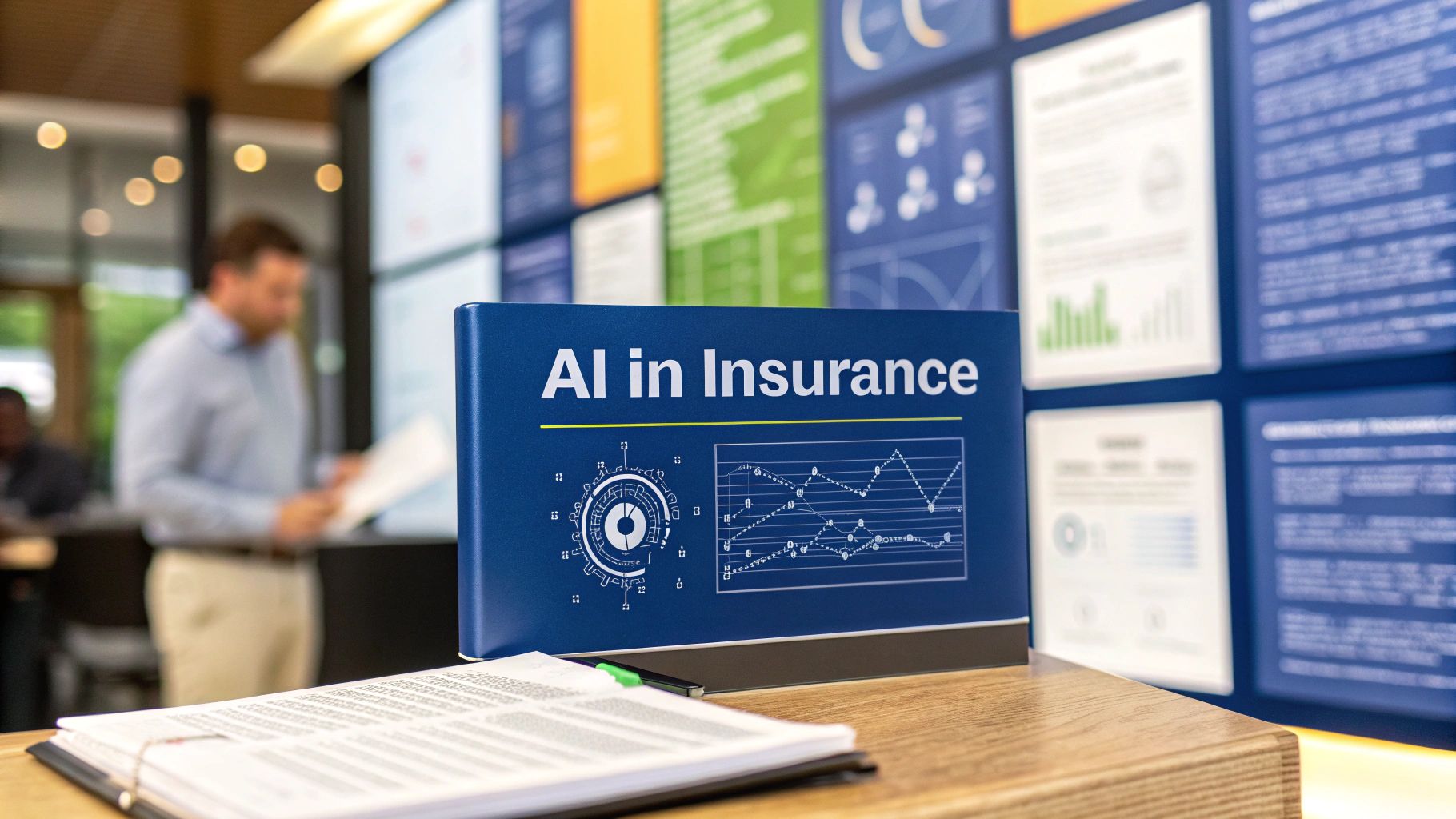Imagine a brilliant assistant working tirelessly alongside every doctor, researcher, and hospital administrator, one that can spot patterns completely invisible to the human eye. This is the new reality of AI in the healthcare industry. It’s not about replacing human experts, but giving them a powerful partner to enhance their skills in ways we've never seen before.
The New Digital Partner in Medicine
At its heart, artificial intelligence in medicine is all about using complex algorithms to make sense of enormous amounts of medical data, and doing it faster and more accurately than humanly possible. Think of it as a highly specialized partner that can sift through millions of patient charts, genetic sequences, or medical images in the blink of an eye.
This gives clinicians the insights they need to make better, more informed decisions. This isn’t some far-off future; it's happening right now.
This technology essentially amplifies the abilities of medical professionals. It might help a radiologist spot the earliest signs of cancer on a scan that could otherwise be missed, or help a researcher pinpoint promising compounds for a new drug, cutting down development time significantly. Ultimately, the goal is to improve patient outcomes by making healthcare more predictive, personal, and efficient.
Augmenting Human Expertise
The real magic of AI is its capacity to take on tasks that are just too big and complex for the human brain. It's incredibly good at finding subtle connections and anomalies that can signal the start of a disease or predict how a patient will react to a certain treatment.
By sifting through incredible quantities of information, AI can figure out how to achieve highly specific outcomes, transforming both diagnostics and research. This capability allows medical professionals to focus less on data processing and more on direct patient care.
This blend of human intuition and machine intelligence is pushing the boundaries of what's possible in medicine. Since effective knowledge management is so vital, understanding how AI-powered knowledge management in healthcare fits into this picture is key to its role as a new digital partner.
Key Areas of Impact
We're already seeing real, tangible benefits from AI across many areas of healthcare. Its use isn't limited to just one niche; it touches the entire patient journey, from the first diagnosis all the way through to treatment and even the administrative side of things.
Here are a few foundational ways AI is acting as a digital partner:
-
Accelerating Diagnostics: AI models, trained on millions of medical images, can flag potential problems in X-rays, MRIs, and CT scans with impressive accuracy, serving as a reliable second opinion for clinicians.
-
Personalizing Treatment Plans: By looking at a patient's unique genetic code, lifestyle, and medical history, AI can suggest customized therapies with a much higher chance of success.
-
Streamlining Hospital Operations: AI tools are taking over administrative work like scheduling, billing, and managing patient data. This not only cuts operational costs but also helps reduce burnout among staff. This often requires unique platforms, and you can learn more about the process of developing custom medical software to handle these needs.
Understanding the AI Technologies Powering Healthcare
To really get a handle on how AI is changing medicine, we need to pop the hood and look at the core technologies making it all happen. These aren't just buzzwords; they're powerful engines, each with a specific job. Think of them as the different specialists on a highly advanced medical team.
At the heart of the AI in healthcare industry is Machine Learning (ML). Picture a medical resident who can absorb millions of patient cases, lab results, and treatment outcomes in a single afternoon. That's essentially what ML systems do; they learn to spot incredibly complex patterns in data that would be completely invisible to a human.
This isn't about feeding a computer a list of "if-then" rules. Instead, ML algorithms are trained on enormous datasets, which allows them to make predictions. For instance, an ML model can analyze a patient's vitals and lab results to predict the odds of sepsis hours before the first physical symptoms even show up. That early warning can be the difference between life and death.
Machine Learning: The Predictive Powerhouse
Machine Learning is the foundation that lets systems learn from experience without needing to be explicitly programmed for every single task. It's the reason AI can do things like forecast disease outbreaks or tailor a treatment plan to an individual's unique genetic makeup.
While there are a few different flavours of ML, they all work toward the same goal: turning raw data into actionable insight.
-
Supervised Learning: Think of this like teaching with flashcards. The AI gets data that's already labelled, like medical images marked "cancerous" or "benign", and it learns to connect the patterns with the correct label.
-
Unsupervised Learning: Here, the AI is given a jumble of unlabelled data and told to find hidden structures on its own. It might group patients with similar characteristics into new clusters, potentially revealing disease subtypes we never knew existed.
-
Reinforcement Learning: This is all about trial and error. The AI learns by getting rewards or penalties for its actions, much like a surgeon refines a new technique over hundreds of procedures to get the best outcome.
To give you a better sense of how these pieces fit together, let's look at some of the most common AI technologies and what they actually do in a clinical setting.
Core AI Technologies and Their Healthcare Functions
The table below breaks down the essential AI technologies and their practical applications in the medical field.
|
AI Technology |
Core Function |
Example Application in Healthcare |
|---|---|---|
|
Machine Learning (ML) |
Learns from data to identify patterns and make predictions. |
Predicting patient risk for conditions like sepsis or heart failure. |
|
Natural Language (NLP) |
Understands, interprets, and generates human language. |
Extracting key data from doctors’ notes or transcribing patient visits. |
|
Computer Vision |
Interprets and analyzes visual information from images. |
Detecting tumours in X-rays or signs of disease in retinal scans. |
|
Deep Learning |
A complex type of ML using neural networks for nuance. |
Analyzing complex genomic data to personalize cancer treatments. |
These technologies aren't working in isolation; they often team up to solve much bigger problems, creating a system that's far more powerful than the sum of its parts.

The image above really shows how this works in practice. AI isn't replacing the expert, but acting as a powerful assistant. It augments a radiologist's ability to interpret complex scans, helping them work with greater speed and precision.
Natural Language Processing: The Universal Translator
Next up is Natural Language Processing (NLP), the tech that gives computers the ability to understand and speak to humans. So much of the critical information in healthcare is locked away in unstructured text like doctors' notes, patient histories, academic papers, and NLP is the key to unlocking it.
An NLP algorithm can scan a physician's scribbled notes or a patient's electronic health record (EHR) and pull out the important stuff, like symptoms, medications, and diagnoses. This saves an incredible amount of time on manual data entry, cuts down on errors, and makes patient data much easier to analyze.
NLP can even go a step further. By analyzing context and sentiment in patient feedback or social media posts, it can spot public health trends and act as an early warning system for potential outbreaks.
One of the most immediate uses of NLP is voice recognition. It allows a clinician to dictate notes directly into a medical record, freeing up their hands and, more importantly, their attention to focus completely on the patient. For a deeper dive, this resource on AI Voice Recognition in Healthcare shows just how much it's improving both efficiency and patient care.
Computer Vision: The Expert Eye
Finally, we have Computer Vision, which gives AI a super-powered sense of sight. This technology trains algorithms to interpret and understand the visual world by analyzing digital images and videos. Its biggest impact in healthcare has been in medical imaging.
Just imagine an AI that has studied millions of MRIs, X-rays, and CT scans. It learns to detect the most subtle abnormalities, a tiny tumour, the earliest signs of diabetic retinopathy, that might be missed by the human eye, even that of a seasoned radiologist.
A 2024 study confirmed that deep-learning tools are already making radiology diagnoses better by analyzing medical data with astounding accuracy. These tools can even help clinicians understand how aggressive a cancer might be, sometimes through "virtual biopsies" that identify tumour properties without an invasive procedure. Computer vision isn't here to replace the radiologist; it's here to be an incredibly vigilant assistant, flagging areas of concern and offering a second opinion in seconds.
Here's a rewritten version of the section, designed to sound more human and natural:
How AI is Already Improving Patient Care
It's one thing to talk about the potential of AI in healthcare, but it’s another to see it making a real difference at the bedside, in the operating room, and in the lab. AI isn't some far-off concept anymore; it's a practical tool that's already helping clinicians deliver better outcomes, improve accuracy, and spend more time focused on their patients.
At its core, AI’s power comes from its ability to process enormous amounts of complex medical data far faster than any human could. It acts like an incredibly sharp assistant, spotting patterns and connections that can lead to smarter, more proactive care.
Catching Diseases Earlier and More Accurately
Medical diagnosis, especially in fields like radiology and pathology, is where AI is having one of its biggest impacts. Algorithms trained on millions of medical images are getting remarkably good at spotting the faintest signs of disease, things a busy clinician might easily overlook.
Imagine a radiologist with a mountain of scans to get through. An AI tool can work in the background, pre-analyzing those images and flagging suspicious areas with incredible precision. We're already seeing deep-learning models that improve diagnostic accuracy for conditions like cancer. Some can even perform "virtual biopsies" by analyzing tumour properties from a scan, potentially avoiding an invasive procedure altogether.
This isn't about replacing a radiologist's judgment. It's about giving them a tireless second pair of eyes. The AI provides an instant second opinion, helping to catch diseases when they're most treatable and cutting down on the risk of human error.
And this technology goes well beyond just cancer. AI is also being used to:
-
Spot Diabetic Retinopathy: AI systems can analyze retinal photos to find early warning signs of this condition, which is a major cause of blindness.
-
Identify Neurological Disorders: Algorithms can analyze brain scans for subtle markers of conditions like Alzheimer's or multiple sclerosis, long before symptoms become severe.
-
Analyze Skin Lesions: Some smartphone apps now use AI to help people determine if a mole or skin lesion looks suspicious, prompting them to see a doctor sooner.
Predicting Problems Before They Happen
Beyond just diagnosing what's already there, AI is great at predicting what might happen next. Hospitals are starting to use predictive models to flag patients who are at high risk for developing serious complications, turning reactive care into proactive care. A perfect example is the ongoing battle against sepsis, a deadly response to infection.
Specialized AI algorithms can quietly monitor a patient's vital signs and lab results in real-time. By catching the subtle patterns that often appear before a patient crashes, these systems can alert nurses and doctors to a high sepsis risk hours – or even a full day – before it becomes obvious. That early warning is everything, as getting treatment started immediately can be the difference between life and death.
In a similar way, these predictive tools help hospitals manage their beds and staff by forecasting admissions and identifying which patients are most likely to be readmitted after discharge.
Bringing More Precision to the Operating Room
The operating room is another place where AI is making a tangible difference. AI-guided robotic surgical assistants aren’t operating on their own. Instead, they act as a seamless extension of the surgeon's hands, dramatically improving their dexterity, control, and precision.
These systems can steady a surgeon’s hand to eliminate natural tremors, allowing for incredibly delicate movements during minimally invasive procedures. The payoff for the patient is huge: smaller incisions, less blood loss, less post-op pain, and a much quicker recovery. All the while, the AI provides the surgeon with real-time data and enhanced visuals, helping them navigate complex anatomy with more confidence. This is a clear example of how the AI in the healthcare industry is creating a powerful partnership between human skill and machine accuracy. You can get a broader look at how AI is helping the healthcare industry in our other article.
Lifting the Administrative Burden
Anyone who works in healthcare knows that a huge chunk of the day is spent on paperwork and administrative tasks, from typing up notes in electronic health records (EHRs) to handling billing codes. This administrative drain is a major cause of burnout and steals precious time that could be spent with patients.
AI is starting to tackle this mountain of paperwork. Tools using Natural Language Processing (NLP) can now listen to a conversation between a doctor and patient and automatically draft the clinical notes. This frees the doctor from the keyboard, allowing them to actually look at their patient and build a better connection. One study found AI scribes delivered a "statistically significant reduction in time in notes per appointment," and both doctors and patients loved it. That time saved goes directly back into providing more focused and empathetic care.
Navigating the Legal Landscape of Medical AI

As AI in healthcare moves from theory to the bedside, it's kicking up a storm of complex legal and ethical questions. With every new algorithm comes a new set of responsibilities. Right now, regulators are scrambling to put up guardrails that protect patients and build trust, all without putting the brakes on progress.
The core of the problem is a classic mismatch: the lightning-fast pace of tech development versus the slow, deliberate world of medical regulation. How can we be sure an algorithm is safe, fair, and not some impenetrable "black box"? If an AI-driven tool gets it wrong, who’s on the hook? These are the tough conversations happening in boardrooms and government halls.
Ultimately, a clear regulatory framework is the only way forward. It draws the lines of accountability between AI developers, hospitals, and the clinicians on the front lines, making sure this powerful technology remains a tool to support care, not complicate it.
Protecting Patient Data and Privacy
The engine of medical AI runs on data like massive, sensitive collections of personal health information. Protecting it isn't just a good idea; it's a legal and ethical must. Regulations like the Health Insurance Portability and Accountability Act (HIPAA) in the United States lay the groundwork, but AI brings its own unique privacy headaches.
AI models need huge datasets to learn, which naturally opens the door to potential breaches and misuse. That’s why healthcare organizations have to be militant about security, de-identifying patient information, and locking down access. Ensuring the ethical and compliant use of HIPAA-compliant AI tools has become a critical piece of the puzzle.
This isn’t just about ticking compliance boxes. It's about earning the trust of patients, without which widespread adoption is just a pipe dream.
Ensuring Transparency and Accountability
When an algorithm has a hand in patient care, transparency is everything. Patients deserve to know if they're interacting with a chatbot or a human doctor. Being upfront manages expectations and keeps the vital clinician-patient relationship intact.
New legal frameworks are starting to tackle this head-on. California, for instance, passed Assembly Bill 3030, which goes into effect on January 1, 2025. This law mandates that healthcare providers must tell patients when generative AI is used for clinical communication and offer a clear path to speak with a person.
Building a trustworthy AI ecosystem means establishing clear accountability. If an AI system contributes to a diagnostic error, determining liability requires a clear understanding of the roles played by the developer, the hospital that deployed it, and the clinician who used its insights.
This evolving legal terrain is setting the standard for how to responsibly weave artificial intelligence in healthcare. You can dive deeper into this topic in our article on artificial intelligence in healthcare.
Balancing Innovation with Patient Safety
At the end of the day, every rule and regulation is there to protect patients. The danger, however, is that overly rigid laws could choke the very innovation that promises to save lives. It's a delicate balancing act for regulators: create frameworks that are tough enough to ensure safety but flexible enough to let new ideas flourish.
Getting this right involves a few key strategies:
-
Rigorous Validation: Insisting that AI models are thoroughly tested on diverse sets of population data before they ever see a real-world patient.
-
Post-Market Surveillance: Keeping a close eye on AI tools after they’ve been deployed to monitor their performance and catch any unexpected problems.
-
Ethical Guidelines: Setting clear ethical standards for AI development and use, with a sharp focus on fairness, equity, and rooting out bias.
By carefully navigating this complex territory, we can help ensure AI grows into a responsible, reliable, and genuinely helpful force in medicine.
Drawing the Line: Preventing AI Misrepresentation in Patient Care
As AI tools become more common in clinics and hospitals, a critical question comes to the forefront: how can we be certain patients always know whether they're talking to a human or an algorithm? For AI in medicine to earn our trust, we need absolute transparency. This isn't just about best practices. It's an ethical line we cannot afford to cross.
The real danger lies in an AI being passed off, accidentally or on purpose, as a licensed medical professional. An AI assistant is great for booking appointments or answering general questions, but it must never create the illusion that it's a doctor. This distinction is everything when it comes to patient safety and preserving the integrity of the clinician-patient relationship.
No matter how sophisticated it gets, an AI chatbot simply doesn't have the nuanced judgment, empathy, or legal accountability of a human doctor. When a patient thinks they're getting advice from a person, they bring a level of trust to that conversation that just isn't appropriate for an automated system. That's why setting clear boundaries is non-negotiable.
Establishing a Clear Boundary
Regulators are starting to step in to create firm rules around this very issue. The goal isn't to hold back technology, but to make sure it's used responsibly. We need to prevent any situation where an AI, by using a professional tone or complex medical terms, could trick a patient into believing they're interacting with a human expert.
California is a prime example of this proactive thinking. In 2025, the state put Assembly Bill 489 (AB 489) into effect, a law that directly addresses the risk of AI "impersonation" in healthcare. It makes it illegal for any AI system to give a patient the impression they are communicating with a licensed professional. This could be as obvious as a chatbot calling itself 'Dr. AI' or as subtle as using language that misleads someone about where the information is coming from. You can find out more about how California is limiting AI development to get a better sense of this approach.
This kind of legislation reinforces a simple but powerful idea: AI is a tool, not a substitute for human expertise. Transparency isn't just a nice feature; it’s the foundation of ethical AI in medicine.
Why this Transparency Can't Be Optional
Maintaining this clear separation is vital for a few key reasons. First, it ensures patients can give genuine informed consent and that they understand the limits of the advice they're getting from a machine. It also protects the profound, irreplaceable value of the human connection in medicine.
To get this right, here are the core principles for ethical AI communication in patient care:
-
Be Upfront: Every single interaction with an AI must start with a clear, unavoidable statement letting the patient know they're communicating with an automated system.
-
No False Credentials: An AI should never use titles like "doctor" or "nurse." It also shouldn't use language that suggests it holds any kind of medical licence.
-
Always Provide an Out: Patients need an easy, immediate way to bypass the AI and speak directly with a human clinician whenever they want.
By building these principles directly into the design of every AI tool used in the healthcare industry, we can make sure technology remains a helpful and trusted partner in the patient journey, not a source of confusion or risk.
Building Fair and Unbiased Healthcare AI

If you train an AI on bad data, you’ll get bad results. It’s a simple truth that points to one of the biggest ethical hurdles for AI in the healthcare industry: making sure the technology is fair, equitable, and free from bias.
An algorithm is really just a reflection of the data it’s fed. When historical medical data mirrors old societal biases, like underrepresenting certain demographics or relying on outdated clinical ideas, an AI will learn and even amplify those flaws. This isn't just a theoretical problem; it can lead to diagnostic tools that are less accurate for some people or predictive models that put certain patient groups at a disadvantage.
Tackling this requires a deliberate, proactive approach. It's not enough to just roll out an AI and hope it works for everyone. The real goal is to build systems that actively correct for historical imbalances, not make them worse. It’s all about creating technology that serves every single person equally, ensuring the future of healthcare AI is better and fairer than its past.
Creating Guardrails Against Algorithmic Bias
Recognizing the very real potential for harm, regulatory bodies are finally starting to set clear standards for AI fairness and safety. We're moving past just talking about the problem and into a phase of implementing solid requirements for how these systems are tested, validated, and monitored long before they ever touch a patient's file.
A major step in this direction came from California, where the Attorney General issued a Healthcare AI Advisory in 2025. This move signals a new era of oversight, putting the responsibility squarely on organizations to audit their AI for safety, ethics, and bias. The advisory even calls out specific unlawful AI practices that could block access to care or produce discriminatory results. To get a better sense of what this means, you can review the top takeaways from California's Healthcare AI guidance.
The underlying principle is crystal clear: an AI tool must be proven safe and fair for all patient populations before it's ever used, not after things go wrong. This puts the onus on developers and healthcare providers to prove they’re committed to equity.
Practical Steps Toward Fairer AI
Getting to truly fair medical AI isn't a one-and-done task. It’s an ongoing effort that hinges on a combination of better data, smarter testing, and constant oversight.
Here are a few of the core strategies being put into practice:
-
Diversifying Training Data: This means actively seeking out and using high-quality, representative data from a wide range of patient populations. The AI needs the full picture of human health to learn properly.
-
Regular Bias Audits: It's crucial to perform routine checks on AI models to find and fix any biases that creep in. This needs to happen both before the system is deployed and continuously after it's in a clinical setting.
-
Transparency in Decision-Making: We need to build AI systems that can actually explain their work. When clinicians can understand why an AI made a certain recommendation, they can properly evaluate it for potential bias.
By weaving these practices into every stage of an AI's life, we can build a solid foundation of trust. It’s how we make sure these powerful tools help close gaps in healthcare, not make them wider.
Frequently Asked Questions About AI in Healthcare
As AI tools become more common in clinics and hospitals, it’s only natural for both patients and medical professionals to have questions. We’re all wondering about the real-world impact, from job security to patient safety. Getting a handle on these issues is crucial if we're going to adopt this technology responsibly.
This section tackles some of the most common questions head-on. The idea is to clear up any confusion about how these advanced systems work, highlighting their incredible potential alongside the practical guardrails that keep them safe and effective.
Will AI Replace Doctors and Nurses?
This is probably the number one question on everyone's mind, and the answer is a clear no. AI in healthcare is designed to be a powerful assistant, not a replacement. Its role is to augment the skills of clinicians, not make them obsolete.
Think of it this way: AI can take on the repetitive, data-heavy tasks that bog down a doctor's or nurse's day. It can analyze thousands of medical images or sort through patient data in seconds, freeing up human experts to focus on what they do best: complex decision-making, patient interaction, and providing empathetic care. The future isn't about machines taking over; it's about a partnership where human expertise directs the insights that AI provides.
A recent study on AI scribes found a "statistically significant reduction in time in notes per appointment." That’s not just a time-saver; it means physicians have more time to actually listen and engage with their patients.
How is Patient Privacy Protected with AI?
Protecting sensitive health information is non-negotiable. Any AI system used in a medical setting has to operate under incredibly strict data privacy regulations, like HIPAA in the United States. This isn't just a suggestion. It's the law, and it's enforced through multiple layers of security.
-
Data Anonymization: Before any data is fed into an AI model for training, all personally identifiable information is stripped away. This makes it impossible to trace the data back to an individual patient.
-
Secure Infrastructure: These platforms are built on fortified, encrypted systems designed to block unauthorized access and prevent data breaches.
-
Rigorous Compliance: Healthcare organizations are legally bound to follow strict protocols when they bring in any new technology that handles patient data. Compliance isn't an afterthought; it's built into the process from day one.
Can We Trust AI to Make Medical Decisions?
This is a key point to understand: an AI system never makes the final medical call on its own. It acts as a sophisticated support tool, offering data-driven insights and recommendations to a qualified clinician. That human expert then uses their training and judgment to make the actual decision.
For example, an AI might flag a tiny, suspicious spot on an X-ray that the human eye could easily miss. However, it's still the radiologist who examines the anomaly, considers the patient's full history, and makes the final diagnosis. This blend of machine precision and human expertise leads to safer, more reliable outcomes than either could ever achieve alone.
At Cleffex Digital Ltd, we build secure, compliant, and intelligent software solutions that help healthcare and life sciences organizations tackle their biggest challenges. Learn how our custom software can support your needs.
